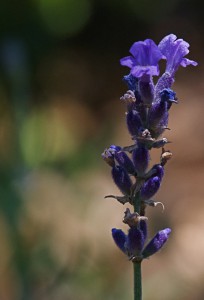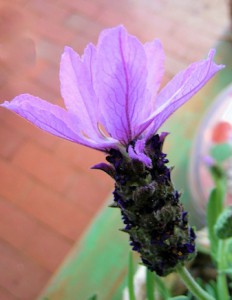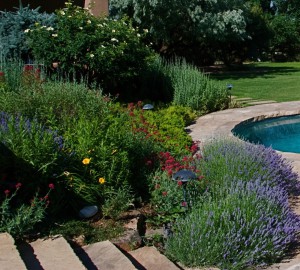Plant Family: Mint (Lamiaceae)
Plant Name: English Lavender (Lavandula angustifolia)
By Janice Tucker
“Spikenard and saffron, calamus and cinnamon, with all trees of frankincense; myrrh and aloes, with all the chief spices”. This verse from The Song of Solomon, 4:14 in the Old Testament is likely the first mention of lavender in its Greek form “spikenard” or “nard”. After enduring trials and tribulations for thousands of years, lavender has earned its merit badge for toughness that is required of plants that thrive in Santa Fe. Even more impressive, this non-native is not invasive to our environment. No wonder Santa Fe gardeners have embraced it.
Native to the Mediterranean, areas in the Middle East, Africa and Southwest Asia, lavender has spread to many regions throughout the world. Other than a few exceptions where L. stoechas is considered invasive, lavender has gained the adulation of gardeners everywhere. Lavender is a staple in English gardens from the humble cottage flowerbeds to grand gardens such as those at Hampton Court, which will be the topic of Santa Fe Botanical Garden’s April 10th lecture presented by Dr. Michael Pulman.
The English lavender (L. angustifolia) and its cultivars, Hidcote, Munstead and Nana are among the favorite lavenders for Santa Fe gardens. These lavenders are cold and drought tolerant, actually prefer our native soil with little or no improvements, and are hardy up to 6500 ft. Garden stars in borders or rock gardens, they bring fragrance, color and texture to flower beds. They are well behaved and get along well with neighboring plants. Blue-gray or silver-green, narrow leaves hug the base of the plant, sending up sturdy spikes that support whorls of flowers in shades of deep purple to light blue. Each of the often-asymmetrical flowers has 5 petals and a tubular calyx. The Nana, Munstead and Hidcote cultivars range in size from 6 inches up to 18 inches in height and width. Leaf and flower colors vary with species and cultivars. Lavandins (Lavandula x intermedia) are widely cultivated hybrids of Lavandula angustifolia and are grown mainly for commercial use. They tend to have larger flowers but are not as fragrant.


Spanish lavender, L. stoechas
The Spanish (L. stoechas) and French (L. dentata) lavenders, as well as their cultivars are becoming more common in Santa Fe. These species are often grown in protected areas or as houseplants. These two species prefer higher humidity than Santa Fe’s dry climate. Spanish lavender has striking bracts at the tip of the flower spike and French lavender is said to be the most fragrant of the 39 Lavandula species.
When spring arrives in Santa Fe and the threat of frost has passed, plant lavender in full sun or partial shade in dry, sandy or gravely soils with little or no amendments. Lavender roots do not like to sit in water and poor drainage can cause root rot. Well-drained soil is paramount. Since organic mulches can trap moisture, it is best to top dress lavenders with sandy, gravel or fine granite mulch.
Plant container lavenders in holes only as deep as the root ball but at least 4 times as wide to allow the lateral roots to travel unimpeded. After the new plants are established, water deeply once or twice a month in spring and summer depending on rainfall and temperatures, and once a month in the winter. In early spring, cut established plants back by half so the new growth will not compete with the tough woody stems from the previous year. Deadhead spent flowers from the first bloom to encourage a second blooming. Lavender is a magnet to bees, butterflies and birds, and as an added bonus, rabbits are not particularly fond of it.

In the mid-to-late1700’s Carl Linnaeus tried to simplify lavender classification by folding the Stoechas genus into the Lavandula genus and by recognizing only 5 species. But, the simplification did not last. Here we are in the 21st century with 3 subgenera, 39 species and goodness knows how many hybrids and cultivars of lavender. Many home gardeners have difficulty in choosing the right lavender due to the similarities among the species, hybrids and cultivars. Consulting with a local nursery or landscape designer will help to make plant selection easier. The Santa Fe Botanical Garden’s list of plants planned for its Museum Hill site names several lavenders that grow well in our area. Download the plant list for the Orchard Gardens (PDF 14kb) >
Lavandula is Latin “lavo”, which means, “to wash”. The genus was so named for the lavender scented soaps, sachets, potpourris, oils and perfumes, which have anointed many a body and scented many a room for thousands of years.
Lavender’s use as a culinary herb often evokes an “ooo” or a “mmm” among dinner guests. For a delicate flavor, add a few sprigs of lavender to hot coals a few minutes before removing a pork roast from the grill. Chocolate and lavender are a great combination and lavender ice cream is a refreshing dessert on a hot summer day. Lavender honey is delicious on hot biscuits or drizzled in a cup of hot tea. Lavender is used extensively in folk medicines to treat a variety of ailments and conditions. It is a favorite in dried flower arrangements and retains its color and fragrance for a long time.
Lavender was highly valued by the ancient Romans and lavishly used by the wealthy in the exclusive bathhouses. During those times, a laborer would have had to pay a month’s wages for a pound of lavender, making it a luxury enjoyed only by those who could afford it.
Even though lavender is still highly esteemed for its fragrant beauty and many uses, fortunately for us it is widely obtainable and affordable today. And despite the many varieties available, it really does not matter what type of lavender blooms in your garden. In her book, Green Thoughts – A Writer in the Garden, Eleanor Perényi says it best, “The lavenders are a lottery, but at least there is no such thing as an ugly one.”



